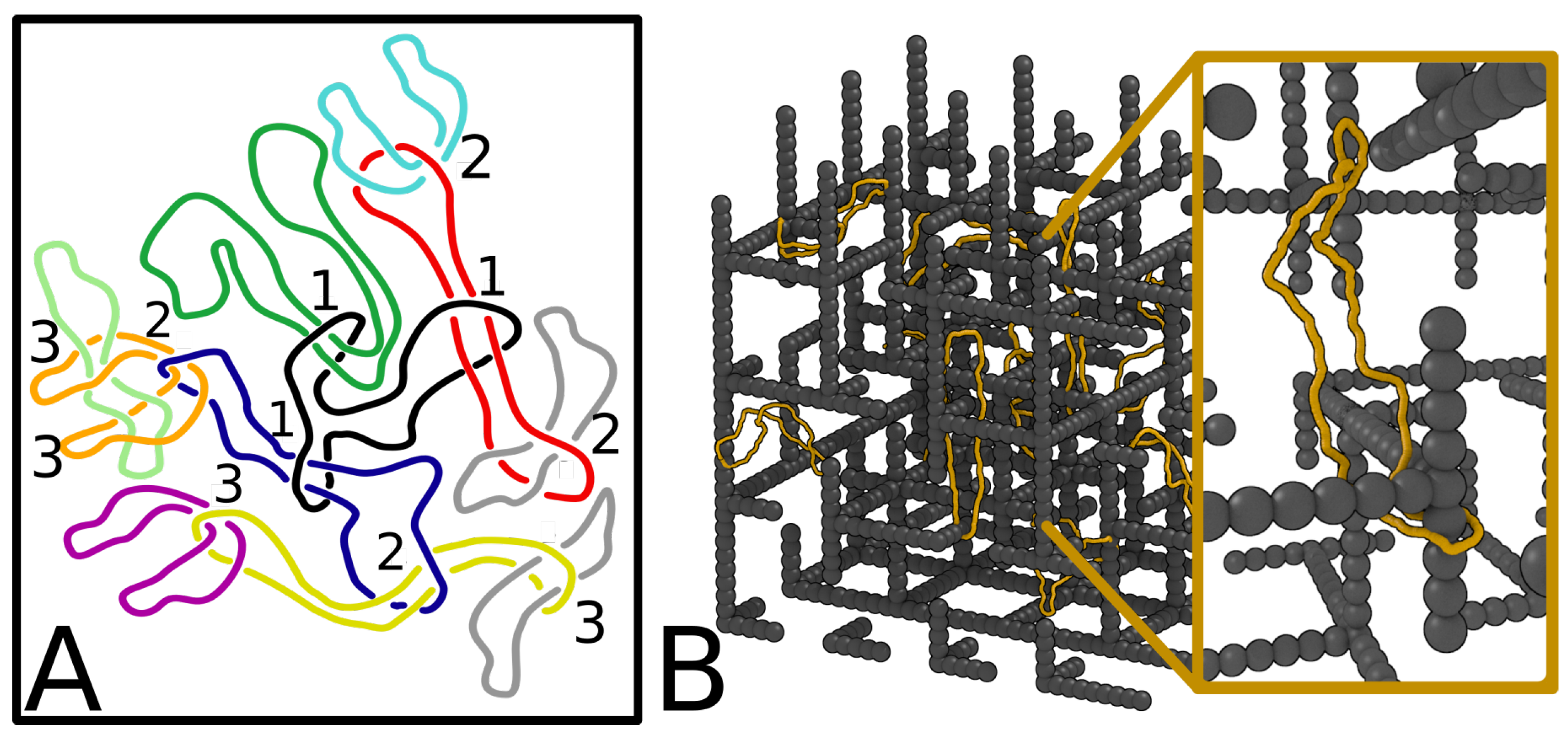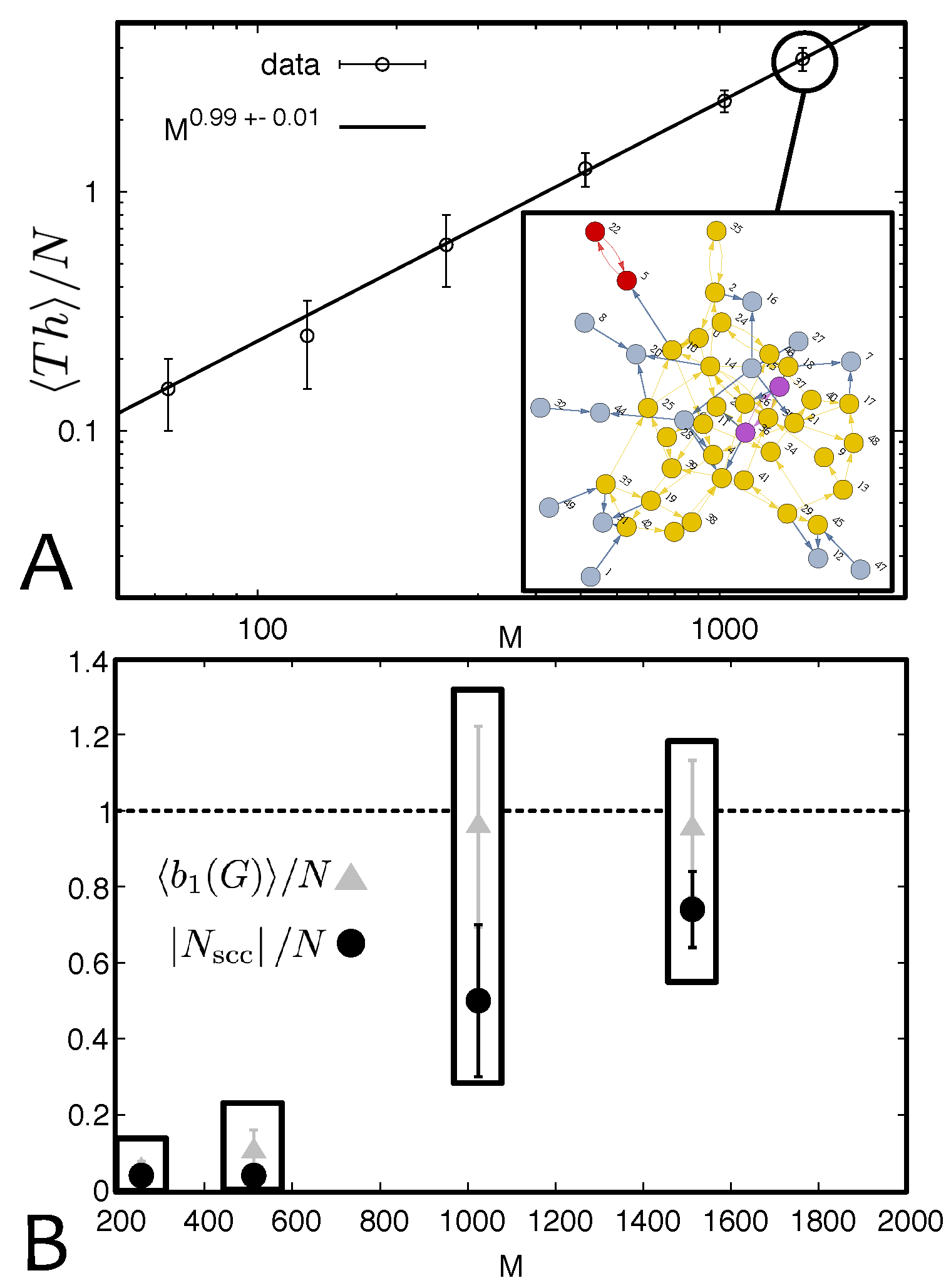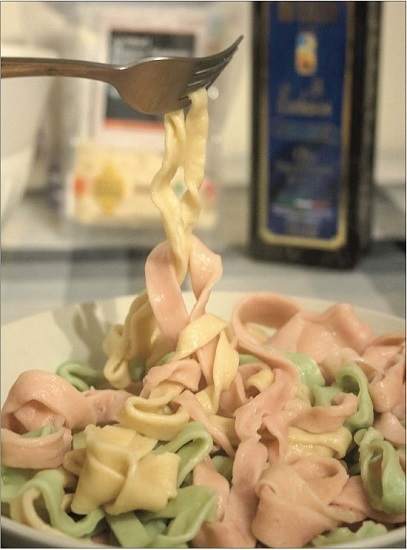Ring Polymers: Threadings, Knot Electrophoresis and Topological Glasses
Abstract
1. Introduction
2. Developing Algorithms to Detect Threadings
2.1. Detecting Threadings between Ring Polymers
2.2. Quantifying Entanglement of Rings with a Disordered Environment
3. Results
3.1. The Statistics of Threading in Ring Polymers
3.2. Polymer Melts and Topological Glasses
3.3. Rings in the Melt as Chains with Mobile Slip-Links
3.4. 2D Gel Electrophoresis of Knotted DNA
4. Discussions and Conclusions
5. Computational Details
Acknowledgments
Author Contributions
Conflicts of Interest
References
- Knott, C. Life and Scientific Work of Peter Guthrie Tait; Paperback Reissue; Cambridge University Press: Cambridge, UK, 2015. [Google Scholar]
- Thomson, W., II. On vortex atoms. Philos. Mag. 1867, 34, 94–105. [Google Scholar] [CrossRef]
- Thomson, W. On Vortex Atoms. Proc. R. Soc. Edinb. 1869, 6, 94–105. [Google Scholar] [CrossRef]
- Maxwell, J.C. The Scientific Papers of James Clerk Maxwell; Dover Publications, Inc.: New York, NY, USA, 1890; p. 541. [Google Scholar]
- Maxwell, J.C. A Paradoxical Ode; University of Salford Manchester: Manchester, UK, 1878. [Google Scholar]
- Kedia, H.; Bialynicki-Birula, I.; Peralta-Salas, D.; Irvine, W.T.M. Tying Knots in Light Fields. Phys. Rev. Lett. 2013, 111, 150404. [Google Scholar] [CrossRef] [PubMed]
- Kleckner, D.; Irvine, W.T.M. Creation and dynamics of knotted vortices. Nat. Phys. 2013, 9, 1–7. [Google Scholar] [CrossRef]
- Machon, T.; Alexander, G.P. Knots and nonorientable surfaces in chiral nematics. Proc. Natl. Acad. Sci. USA 2013, 110, 14174–14179. [Google Scholar] [CrossRef] [PubMed]
- Michieletto, D.; Baiesi, M.; Orlandini, E.; Turner, M.S. Rings in random environments: Sensing disorder through topology. Soft Matter 2015, 11, 1100–1106. [Google Scholar] [CrossRef] [PubMed]
- Halverson, J.D.; Lee, W.B.; Grest, G.S.; Grosberg, A.Y.; Kremer, K. Molecular dynamics simulation study of nonconcatenated ring polymers in a melt. I. Statics. J. Chem. Phys. 2011, 134, 204904. [Google Scholar] [CrossRef] [PubMed]
- Halverson, J.D.; Lee, W.B.; Grest, G.S.; Grosberg, A.Y.; Kremer, K. Molecular dynamics simulation study of nonconcatenated ring polymers in a melt. II. Dynamics. J. Chem. Phys. 2011, 134, 204905. [Google Scholar] [CrossRef] [PubMed]
- Kapnistos, M.; Lang, M.; Vlassopoulos, D.; Pyckhout-Hintzen, W.; Richter, D.; Cho, D.; Chang, T.; Rubinstein, M. Unexpected power-law stress relaxation of entangled ring polymers. Nat. Mater. 2008, 7, 997–1002. [Google Scholar] [CrossRef] [PubMed]
- Mickel, S.; Arena, V.; Bauer, W. Physical properties and gel electrophoresis behavior of R12-derived plasmid DNAs. Nucleic Acids Res. 1977, 4, 1465–1482. [Google Scholar] [CrossRef] [PubMed]
- Levene, S.D.; Zimm, B.H. Separations of open-circular DNA using pulsed-field electrophoresis. Proc. Natl. Acad. Sci. USA 1987, 84, 4054–4057. [Google Scholar] [CrossRef] [PubMed]
- Smrek, J.; Grosberg, A.Y. Minimal Surfaces on Unconcatenated Polymer Rings in Melt. ACS Macro Lett. 2016, 5, 750–754. [Google Scholar] [CrossRef]
- Lang, M. Ring Conformations in Bidisperse Blends of Ring Polymers. Macromolecules 2013, 46, 1158–1166. [Google Scholar] [CrossRef]
- Lee, E.; Kim, S.; Jung, Y. Slowing Down of Ring Polymer Diffusion Caused by Inter-Ring Threading. Macromol. Rapid Commun. 2015, 36, 1115–1121. [Google Scholar] [CrossRef] [PubMed]
- Tsalikis, D.; Mavrantzas, V. Threading of Ring Poly(ethylene oxide) Molecules by Linear Chains in the Melt. ACS Macro Lett. 2014, 3, 763–766. [Google Scholar] [CrossRef]
- Tsalikis, D.G.; Mavrantzas, V.G.; Vlassopoulos, D. Analysis of Slow Modes in Ring Polymers: Threading of Rings Controls Long-Time Relaxation. ACS Macro Lett. 2016, 5, 755–760. [Google Scholar] [CrossRef]
- Stasiak, A.; Katritch, V.; Bednar, J.; Michoud, D.; Dubochet, J. Electrophoretic mobility of DNA knots. Nature 1996, 384, 122. [Google Scholar] [CrossRef] [PubMed]
- Tubiana, L.; Orlandini, E.; Micheletti, C. Probing the Entanglement and Locating Knots in Ring Polymers: A Comparative Study of Different Arc Closure Schemes. Prog. Theor. Phys. Suppl. 2011, 191, 192–204. [Google Scholar] [CrossRef]
- Michieletto, D.; Marenduzzo, D.; Orlandini, E.; Alexander, G.; Turner, M. Threading Dynamics of Ring Polymers in a Gel. ACS Macro Lett. 2014, 3, 255–259. [Google Scholar] [CrossRef]
- Lubensky, T.C.; Isaacson, J. Statistics of lattice animals and dilute branched polymers. Phys. Rev. A 1979, 20, 2130–2146. [Google Scholar] [CrossRef]
- Michieletto, D.; Turner, M.S. A topologically driven glass in ring polymers. Proc. Natl. Acad. Sci. USA 2016, 113, 5195–5200. [Google Scholar] [CrossRef] [PubMed]
- Michieletto, D. On the tree-like structure of rings in dense solutions. Soft Matter 2016, 12, 9485–9500. [Google Scholar] [CrossRef] [PubMed]
- Åkerman, B.; Cole, K. Electrophoretic capture of circular DNA in gels. Electrophoresis 2002, 23, 2549–2561. [Google Scholar] [CrossRef]
- Rahong, S.; Yasui, T.; Yanagida, T.; Nagashima, K.; Kanai, M.; Klamchuen, A.; Meng, G.; He, Y.; Zhuge, F.; Kaji, N.; et al. Ultrafast and wide range analysis of DNA molecules using rigid network structure of solid nanowires. Sci. Rep. 2014, 4, 5252. [Google Scholar] [CrossRef] [PubMed]
- Katritch, V.; Bednar, J.; Michoud, D.; Scharein, R.; Dubochet, J.; Stasiak, A. Geometry and physics of knots. Nature 1996, 384, 142–145. [Google Scholar] [CrossRef]
- Cole, K.D.; Åkerman, B. The Influence of Agarose Concentration In Gels On The Electrophoretic Trapping Of Circular Dna. Sep. Sci. Technol. 2003, 38, 2121–2136. [Google Scholar] [CrossRef]
- Guenet, J.M.; Rochas, C. Agarose Sols and Gels Revisited. Macromol. Symp. 2006, 242, 65–70. [Google Scholar] [CrossRef]
- Michieletto, D.; Marenduzzo, D.; Orlandini, E. Topological patterns in two-dimensional gel electrophoresis of DNA knots. Proc. Natl. Acad. Sci. USA 2015, 112, E5471–E5477. [Google Scholar] [CrossRef] [PubMed]
- Michieletto, D. Topological Interactions in Ring Polymers; Springer Theses; Springer International Publishing: Cham, Switzerland, 2016; p. 166. [Google Scholar]
- Grosberg, A.Y.; Rabin, Y.; Havlin, S.; Neer, A. Crumpled globule model of the three-dimensional structure of DNA. Europhys. Lett. 1993, 23, 373–378. [Google Scholar] [CrossRef]
- Cates, M.; Deutsch, J. Conjectures on the statistics of ring polymers. J. Phys. 1986, 47, 2121–2128. [Google Scholar] [CrossRef]
- Nechaev, S.K.; Semenov, A.N.; Koleva, M.K. Dynamics of a polymer in an array of obstacles. Physica A 1987, 140, 506–520. [Google Scholar] [CrossRef]
- Sakaue, T. Ring Polymers in Melts and Solutions: Scaling and Crossover. Phys. Rev. Lett. 2011, 106, 167802. [Google Scholar] [CrossRef] [PubMed]
- Rosa, A.; Everaers, R. Ring polymers in the melt state: The physics of crumpling. Phys. Rev. Lett. 2014, 112, 118302. [Google Scholar] [CrossRef] [PubMed]
- Nahali, N.; Rosa, A. Density effects in entangled solutions of linear and ring polymers. J. Phys. Condens. Matter 2016, 28, 065101. [Google Scholar] [CrossRef] [PubMed]
- Muller, M.; Wittmer, J.; Cates, M.E. Topological effects in ring polymers. II. Influence of persistence length. Phys. Rev. E 2000, 61, 4078–4089. [Google Scholar] [CrossRef]
- Müller, M.; Wittmer, J.; Cates, M.E. Topological effects in ring polymers: A computer simulation study. Phys. Rev. E 1996, 53, 5063–5074. [Google Scholar] [CrossRef]
- Rosa, A.; Orlandini, E.; Tubiana, L. Structure and dynamics of ring polymers: Entanglement effects because of solution density and ring topology. Macromolecules 2011, 44, 8668–8680. [Google Scholar] [CrossRef]
- Grosberg, A. Annealed lattice animal model and Flory theory for the melt of non-concatenated rings: Towards the physics of crumpling. Soft Matter 2014, 10, 560–565. [Google Scholar] [CrossRef] [PubMed]
- Newman, M. Networks: An Introduction; Oxford University Press: Oxford, UK, 2010. [Google Scholar]
- Michieletto, D.; Turner, M. A taste for anelloni. Phys. World 2014, 27, 28–31. [Google Scholar] [CrossRef]
- Vlassopoulos, D. Macromolecular topology and rheology: Beyond the tube model. Rheol. Acta 2016, 55, 613–632. [Google Scholar] [CrossRef]
- Milner, S.T.; Newhall, J. Stress Relaxation in Entangled Melts of Unlinked Ring Polymers. Phys. Rev. Lett. 2010, 105, 208302. [Google Scholar] [CrossRef] [PubMed]
- Ge, T.; Panyukov, S.; Rubinstein, M. Self-Similar Conformations and Dynamics in Entangled Melts and Solutions of Nonconcatenated Ring Polymers. Macromolecules 2016, 9, 708–722. [Google Scholar] [CrossRef] [PubMed]
- Smrek, J.; Grosberg, A.Y. Understanding the dynamics of rings in the melt in terms of annealed tree model. J. Phys. Condens. Matter 2015, 27, 064117. [Google Scholar] [CrossRef] [PubMed]
- McLeish, T. Polymers without beginning or end. Science 2002, 297, 2005–2006. [Google Scholar] [CrossRef] [PubMed]
- McLeish, T.C.B. Floored by the rings. Nature 2008, 7, 933–935. [Google Scholar] [CrossRef] [PubMed]
- Lo, W.C.; Turner, M.S. The topological glass in ring polymers. Europhys. Lett. 2013, 102, 58005. [Google Scholar] [CrossRef]
- Jones, R.A. Soft Condensed Matter; Oxford University Press: Oxford, UK, 2002. [Google Scholar]
- Doi, M.; Edwards, S. The Theory of Polymer Dynamics; Oxford University Press: Oxford, UK, 1988. [Google Scholar]
- De Gennes, P.G. Scaling Concepts in Polymer Physics; Cornell University Press: Ithaca, NY, USA, 1979. [Google Scholar]
- Rubinstein, M. Dynamics of ring polymers in the presence of fixed obstacles. Phys. Rev. Lett. 1986, 57, 3023–3026. [Google Scholar] [CrossRef] [PubMed]
- Cammarota, C.; Biroli, G. Ideal glass transitions by random pinning. Proc. Natl. Acad. Sci. USA 2012, 109, 8850–8855. [Google Scholar] [CrossRef] [PubMed]
- Lodge, T.P.; McLeish, T.C.B. Self-concentrations and effective glass transition temperatures in polymer blends. Macromolecules 2000, 33, 5278–5284. [Google Scholar] [CrossRef]
- Gokhale, S.; Nagamanasa, K.H.; Ganapathy, R.; Sood, A.K. Growing Dynamical Facilitation on Approaching the Random Pinning Colloidal Glass Transition. Nat. Commun. 2014, 5, 1–13. [Google Scholar] [CrossRef] [PubMed]
- Karmakar, S.; Parisi, G. Random pinning glass model. Proc. Natl. Acad. Sci. USA 2013, 110, 1–6. [Google Scholar] [CrossRef] [PubMed]
- Nagamanasa, K.H.; Gokhale, S.; Ganapathy, R.; Sood, A.K. Confined glassy dynamics at grain boundaries in colloidal crystals. Proc. Natl. Acad. Sci. USA 2011, 108, 11323–11326. [Google Scholar] [CrossRef] [PubMed]
- Nagamanasa, K.H.; Gokhale, S.; Sood, A.K.; Ganapathy, R. Direct measurements of growing amorphous order and non-monotonic dynamic correlations in a colloidal glass-former. Nat. Phys. 2015, 11, 403–408. [Google Scholar] [CrossRef]
- Weeks, E.R. Amorphous solids: Glasses pinned down. Nat. Phys. 2015, 11, 381–382. [Google Scholar] [CrossRef]
- Kob, W.; Coslovich, D. Nonlinear dynamic response of glass-forming liquids to random pinning. Phys. Rev. E 2014, 90, 052305. [Google Scholar] [CrossRef] [PubMed]
- Chakrabarty, S.; Karmakar, S.; Dasgupta, C. Phase Diagram of Glass Forming Liquids with Randomly Pinned Particles. arXiv, 2014; arXiv:1404.2701. [Google Scholar]
- Michieletto, D.; Nahali, N.; Rosa, A. Glassiness and Heterogeneous Dynamics in Dense Solutions of Ring Polymers. arXiv, 2017; arXiv:1703.09688. [Google Scholar]
- Brackley, C.A.; Michieletto, D.; Mouvet, F.; Johnson, J.; Kelly, S.; Cook, P.R.; Marenduzzo, D. Simulating topological domains in human chromosomes with a fitting-free model. Nucleus 2016, 7, 453–461. [Google Scholar] [CrossRef] [PubMed]
- Alberts, B.; Johnson, A.; Lewis, J.; Morgan, D.; Raff, M. Molecular Biology of the Cell; Taylor & Francis: Oxford, NY, USA, 2014; p. 1464. [Google Scholar]
- Mirny, L.A. The fractal globule as a model of chromatin architecture in the cell. Chromosome Res. 2011, 19, 37–51. [Google Scholar] [CrossRef] [PubMed]
- Duplantier, B. Statistical mechanics of polymer networks of any topology. J. Stat. Phys. 1989, 54, 581–680. [Google Scholar] [CrossRef]
- Metzler, R.; Hanke, A.; Dommersnes, P.G.; Kantor, Y.; Kardar, M. Tightness of slip-linked polymer chains. Phys. Rev. E 2002, 65, 1–9. [Google Scholar] [CrossRef] [PubMed]
- Arsuaga, J.; Vazquez, M.; McGuirk, P.; Trigueros, S.; Sumners, D.W.; Roca, J. DNA knots reveal a chiral organization of DNA in phage capsids. Proc. Natl. Acad. Sci. USA 2005, 102, 9165–9169. [Google Scholar] [CrossRef] [PubMed]
- Trigueros, S.; Arsuaga, J.; Vazquez, M.E.; Sumners, D.; Roca, J. Novel display of knotted DNA molecules by two-dimensional gel electrophoresis. Nucleic Acids Res. 2001, 29, 67. [Google Scholar] [CrossRef]
- Trigueros, S.; Roca, J. Production of highly knotted DNA by means of cosmid circularization inside phage capsids. BMC Biotechnol. 2007, 7, 94. [Google Scholar] [CrossRef] [PubMed]
- Weber, C.; Stasiak, A.; De Los Rios, P.; Dietler, G. Numerical simulation of gel electrophoresis of DNA knots in weak and strong electric fields. Biophys. J. 2006, 90, 3100–3105. [Google Scholar] [CrossRef] [PubMed]
- Weber, C.; De Los Rios, P.; Dietler, G.; Stasiak, A. Simulations of electrophoretic collisions of DNA knots with gel obstacles. J. Phys. Condens. Matter 2006, 18, S161–S171. [Google Scholar] [CrossRef]
- Cebrián, J.; Kadomatsu-Hermosa, M.J.; Castán, A.; Martínez, V.; Parra, C.; Fernández-Nestosa, M.J.; Schaerer, C.; Martínez-Robles, M.L.; Hernández, P.; Krimer, D.B.; et al. Electrophoretic mobility of supercoiled, catenated and knotted DNA molecules. Nucleic Acids Res. 2014, 43. [Google Scholar] [CrossRef] [PubMed]
- Roovers, J. Melt Properties of Ring Polystyrenes. Macromolecules 1985, 18, 1361–1362. [Google Scholar] [CrossRef]
- Klein, D.J. Dynamics of entangled linear, branched, and cyclic polymers. Macromolecules 1986, 118, 105–118. [Google Scholar] [CrossRef]
- McKenna, G.B.; Hadziioannou, G.; Lutz, P.; Hild, G.; Strazielle, C.; Straupe, C.; Rempp, P.; Kovacs, A.J. Dilute solution characterization of cyclic polystyrene molecules and their zero-shear viscosity in the melt. Macromolecules 1987, 20, 498–512. [Google Scholar] [CrossRef]
- Mills, P.J.; Mayer, J.W.; Kramer, E.J.; Hadziioannou, G.; Lutz, P.; Strazielle, C.; Rempp, P.; Kovacs, A.J. Diffusion of polymer rings in linear polymer matrices. Macromolecules 1987, 20, 513–518. [Google Scholar] [CrossRef]
- Tead, S.F.; Kramer, E.J.; Hadziioannou, G.; Antonietti, M.; Sillescu, H.; Lutz, P.; Strazielle, C. Polymer topology and diffusion: A comparison of diffusion in linear and cyclic macromolecules. Macromolecules 1992, 25, 3942–3947. [Google Scholar] [CrossRef]
- Chremos, A.; Douglas, J.F. Communication: When does a branched polymer become a particle? J. Chem. Phys. 2015, 143. [Google Scholar] [CrossRef] [PubMed]
- Antonietti, M.; Pakula, T.; Bremser, W. Rheology of Small Spherical Polystyrene Microgels: A Direct Proof for a New Transport Mechanism in Bulk Polymers besides Reptation. Macromolecules 1995, 28, 4227–4233. [Google Scholar] [CrossRef]
- Doi, Y.; Takano, A.; Takahashi, Y.; Matsushita, Y. Melt Rheology of Tadpole-Shaped Polystyrenes. Macromolecules 2015, 48, 8667–8674. [Google Scholar] [CrossRef]
- Robertson, R.M.; Laib, S.; Smith, D.E. Diffusion of isolated DNA molecules: Dependence on length and topology. Proc. Natl. Acad. Sci. USA 2006, 103, 7310–7314. [Google Scholar] [CrossRef] [PubMed]
- Robertson, R.M.; Smith, D.E. Strong effects of molecular topology on diffusion of entangled DNA molecules. Proc. Natl. Acad. Sci. USA 2007, 104, 4824–4827. [Google Scholar] [CrossRef] [PubMed]
- Yang, Y.B.; Sun, Z.Y.; Fu, C.L.; An, L.J.; Wang, Z.G. Monte Carlo simulation of a single ring among linear chains: Structural and dynamic heterogeneity. J. Chem. Phys. 2010, 133, 064901. [Google Scholar] [CrossRef] [PubMed]
- Chapman, C.; Shanbhag, S.; Smith, D.E.; Robertson, R.M. Complex effects of molecular topology on diffusion in entangled biopolymer blends. Soft Matter 2012, 8, 9177. [Google Scholar] [CrossRef]
- Habuchi, S.; Fujiwara, S.; Yamamoto, T.; Vacha, M.; Tezuka, Y. Single-Molecule Study on Polymer Diffusion in a Melt State: Effect of Chain Topology. Anal. Chem. 2013, 85, 7369–7376. [Google Scholar] [CrossRef] [PubMed]
- Shanbhag, S. Unusual dynamics of ring probes in linear matrices. J. Polym. Sci. Part B Polym. Phys. 2017, 55, 169–177. [Google Scholar] [CrossRef]
- Kremer, K.; Grest, G.S. Dynamics of entangled linear polymer melts: A molecular-dynamics simulation. J. Chem. Phys. 1990, 92, 5057. [Google Scholar] [CrossRef]
- Plimpton, S. Fast Parallel Algorithms for Short—Range Molecular Dynamics. J. Comput. Phys. 1995, 117, 1–19. [Google Scholar] [CrossRef]










© 2017 by the authors. Licensee MDPI, Basel, Switzerland. This article is an open access article distributed under the terms and conditions of the Creative Commons Attribution (CC BY) license (http://creativecommons.org/licenses/by/4.0/).
Share and Cite
Michieletto, D.; Marenduzzo, D.; Orlandini, E.; Turner, M.S. Ring Polymers: Threadings, Knot Electrophoresis and Topological Glasses. Polymers 2017, 9, 349. https://doi.org/10.3390/polym9080349
Michieletto D, Marenduzzo D, Orlandini E, Turner MS. Ring Polymers: Threadings, Knot Electrophoresis and Topological Glasses. Polymers. 2017; 9(8):349. https://doi.org/10.3390/polym9080349
Chicago/Turabian StyleMichieletto, Davide, Davide Marenduzzo, Enzo Orlandini, and Matthew S. Turner. 2017. "Ring Polymers: Threadings, Knot Electrophoresis and Topological Glasses" Polymers 9, no. 8: 349. https://doi.org/10.3390/polym9080349
APA StyleMichieletto, D., Marenduzzo, D., Orlandini, E., & Turner, M. S. (2017). Ring Polymers: Threadings, Knot Electrophoresis and Topological Glasses. Polymers, 9(8), 349. https://doi.org/10.3390/polym9080349





